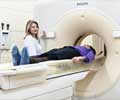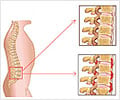CT scan helps to find low bone density beforehand which affects patient treatment plan before, during and after spine surgery.

‘It is essential to screen all patients for low bone density before a surgery to give appropriate treatment.’
Read More..




Almost half of the nearly 300 patients tested were diagnosed with osteoporosis or its precursor, osteopenia for the first time. Some, but not all, had undergone a prior DXA bone density scan. The research, titled, "Prevalence of Osteopenia and Osteoporosis Diagnosed by Quantitative Computed Tomography in 296 Consecutive Lumbar Fusion Patients" was presented today at the American Academy of Orthopaedic Surgeons Annual Meeting in Las Vegas. Read More..
"Metabolic bone disease is a major public health concern. In 2010, the U.S. prevalence of low bone mineral density in adults 50 and older was 44 percent, and 10.3 percent had a diagnosis of osteoporosis," says Dr. Alexander Hughes, an orthopedic surgeon specializing in spine surgery at HSS and senior investigator. "Low bone density is a known risk factor for vertebral fractures, and there is a recent emphasis by spinal surgeons to evaluate and treat this prior to elective spine fusion."
Spinal fusion is a very common surgery, with 400,000 to 500,000 such procedures performed in the United States each year. Two-thirds are fusions in the lumbar, or lower, spine.
The standard test to measure bone strength is dual energy X-ray absorptiometry (DXA or DEXA), a type of flat x-ray that reads bone mineral content. Quantitative computed tomography (QCT) measures bone mineral density with a CT scanner, resulting in a 3D image.
"The literature reporting QCT-based lumbar spine bone density is scarce, and we believe our study is the first of its kind," said Dr. Hughes. "The purpose was to measure lumbar spine bone density using QCT and determine the prevalence of osteopenia or osteoporosis in patients undergoing lumbar spine fusions. We believe that QCT is more effective in screening patients because the DXA scan can overestimate bone density in the spine due to certain bone changes, a patient's weight or physique, and other factors."
Advertisement
The study enrolled 296 patients undergoing lumbar spine fusion for a degenerative condition or spinal instability. Fifty-five percent were female, and the mean age was 63 years old, with patients ranging in age from 21 to 89 years old. All patients had preoperative QCT scans of their lumbar spine. Using American College of Radiology criteria, 44 percent of patients were diagnosed with osteopenia; 15 percent had osteoporosis; and 41 percent were diagnosed with normal bone density.
Advertisement
"Spine surgeons should be aware of the high prevalence of abnormal bone mineral density in lumbar spine patients and the possibility that those without a previous diagnosis may have osteopenia or osteoporosis," Dr. Hughes said. "Diagnosing this prior to spine fusion could lead to a change in surgical planning and treatment, and we believe this would improve outcomes."
Source-Eurekalert












